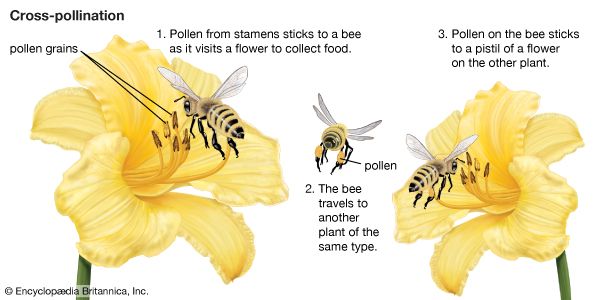pollination
Our editors will review what you’ve submitted and determine whether to revise the article.
- Cool Kid Facts - Pollination
- Easy Science for Kids - Pollination and Fertilization of Plants
- New England Primate Conservancy - What is Pollination
- University of Missouri Extension - Pollination Mechanisms and Plant-Pollinator Relationships
- Purdue University - Yard and Garden - Pollination of Fruits and Nuts
- Biology LibreTexts - Methods of Pollination
- National Center for Biotechnology Information - Pollination
- Smithsonian Gardens - The Why, What, When, Where, Who, How of Pollination
- Key People:
- Prospero Alpini
- Related Topics:
- cross-pollination
- buzz pollination
- pollen tube
- self-pollination
- chiropterophily
pollination, transfer of pollen grains from the stamens (the flower parts that produce them) to the ovule-bearing organs or to the ovules (seed precursors) themselves. In gymnosperm plants such as conifers and cycads, in which the ovules are exposed, the pollen is simply caught in a drop of fluid secreted by the ovule. In flowering plants, however, the ovules are contained within a hollow organ called the pistil, and the pollen is deposited on the pistil’s receptive surface, the stigma. There the pollen germinates and gives rise to a pollen tube, which grows down through the pistil toward one of the ovules in its base. In an act of double fertilization, one of the two sperm cells within the pollen tube fuses with the egg cell of the ovule, making possible the development of an embryo, and the other cell combines with the two subsidiary sexual nuclei of the ovule, which initiates formation of a reserve food tissue, the endosperm. The growing ovule then transforms itself into a seed.
As a prerequisite for fertilization, pollination is essential to the perpetuation of the vast majority of the world’s wild plants as well as to the production of most fruit and seed crops. It also plays an important part in programs designed to improve plants by breeding. Furthermore, studies of pollination are invaluable for understanding the evolution of flowering plants and their distribution in the world today. As sedentary organisms, plants usually must enlist the services of external agents for pollen transport. In flowering plants, these are (roughly in order of diminishing importance) insects, wind, birds, mammals, and water.
Types: self-pollination and cross-pollination
An egg cell in an ovule of a flower may be fertilized by a sperm cell derived from a pollen grain produced by that same flower or by another flower on the same plant, in either of which two cases fertilization is said to be due to self-pollination (autogamy); or, the sperm may be derived from pollen originating on a different plant individual, in which case the process is called cross-pollination (heterogamy). Both processes are common, but cross-pollination clearly has certain evolutionary advantages for the species: the seeds formed may combine the hereditary traits of both parents, and the resulting offspring generally are more varied than would be the case after self-pollination. In a changing environment, some of the individuals resulting from cross-pollination still may be found capable of coping with their new situation, ensuring survival of the species, whereas the individuals resulting from self-pollination might all be unable to adjust. Self-pollination, or selfing, although foolproof in a stable environment, thus is an evolutionary cul-de-sac. There also is a more direct, visible difference between selfing and outbreeding (cross-pollination): in those species where both methods work, cross-pollination usually produces more, and better quality, seeds. A dramatic demonstration of this effect is found with hybrid corn (maize), a superior product that results from cross-breeding of several especially bred lines.


























